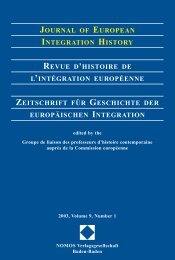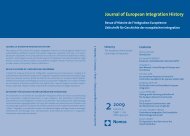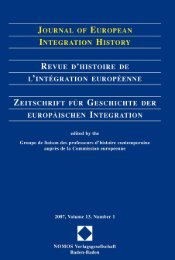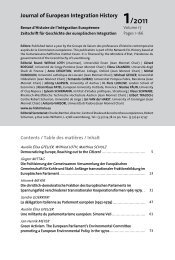journal of european integration history revue d'histoire de l ...
journal of european integration history revue d'histoire de l ...
journal of european integration history revue d'histoire de l ...
You also want an ePaper? Increase the reach of your titles
YUMPU automatically turns print PDFs into web optimized ePapers that Google loves.
24N. Piers Ludlowan Community and believed that one <strong>of</strong> its key assets in carrying out this dynamic taskwas its unique capacity to <strong>de</strong>termine the direction into which the Community moved.As Hallstein explained at length in a lecture in London in March 1965 which in manyways represents the high water mark <strong>of</strong> his institutional ambitions (it was <strong>de</strong>livered amere three months before the outbreak <strong>of</strong> the empty chair crisis), the Commission’smonopoly <strong>of</strong> the right to propose Community legislation gave it a unique capacity to directthe Community and represented a clear <strong>de</strong>monstration <strong>of</strong> the political in<strong>de</strong>pen<strong>de</strong>nceenjoyed by the Brussels body. 59 Member states could and did ask for legislativeproposals to be ma<strong>de</strong>; but the Commission was un<strong>de</strong>r no obligation to heed these requests.60 Furthermore the Commission had shown in 1962, in 1964 and again in 1969that it could use this power to set the Community agenda to draw up extensive workprogrammes, <strong>de</strong>signed to map the EEC’s course over a year or two ahead.Even before Hallstein <strong>de</strong>livered his London speech, however, this ability to plotthe Community’s course had been un<strong>de</strong>r threat. In 1963 it had been a member state– West Germany acting through its foreign minister Gerhard Schrö<strong>de</strong>r – that had<strong>de</strong>vised the action plan that had pulled the EEC out <strong>of</strong> the crisis caused by the failure<strong>of</strong> the first enlargement talks. 61 And over subsequent years Germany in particular,but latterly other member states also, revealed signs <strong>of</strong> having acquired a tastefor such behaviour, submitting a succession <strong>of</strong> action programmes and work timetables.62 The Commission’s own efforts, meanwhile, whether in 1962, 1964 or1969 had remained largely unimplemented. The success rate <strong>of</strong> unilateral nationalattempts to set the Community agenda was sufficiently patchy, however, for theCommission still to feel that it retained some claim to be able to set the Communityagenda in the short and medium term. It did after all still control the timing <strong>of</strong> most<strong>of</strong> the single legislative proposals. Its 1969 effort, moreover, suggested that it perceiveda role in bringing together and making more coherent the multiple nationalsuggestions for Community advance that had already been ma<strong>de</strong>. 63 An agenda setby agreement between all six Heads <strong>of</strong> State and government was entirely different.It would be very hard for any Council <strong>of</strong> ministers meeting to ignore such a document.By the same token, however, it was all but impossible for the Commission todisregard it. As a result it could be construed as a serious blow to the Commission’shighly valued autonomy and in<strong>de</strong>pen<strong>de</strong>nce. No longer would Rey and his colleaguesbe able to <strong>de</strong>ci<strong>de</strong> what targets to work towards or what priorities to i<strong>de</strong>ntify.59. ECHA, speeches collection, Hallstein lecture to the British Institute <strong>of</strong> International andComparative Law, 25.03.1965.60. Ibid.61. Schrö<strong>de</strong>r’s plan is examined in some <strong>de</strong>pth in O. BANGE, Picking Up the Pieces. Schrö<strong>de</strong>r’sWorking Programme for the European Communities and the solution <strong>of</strong> the 1963 crisis,Unpublished Ph.D, London, 1997, pp.158-225.62. Germany had submitted plans in 1964 and 1967, France one in 1968. See CMA, R/121/64,Procès-verbal <strong>de</strong> la réunion restreinte <strong>de</strong> la 121 e session du Conseil CEE (03-05.02.1964); R/601/67, Procès-verbal <strong>de</strong> la 212 e session <strong>de</strong> la Conseil CEE (10-12.04.1967); R/2111/68, Procès-verbal<strong>de</strong> la 51 e session du Conseil (04-05.11.1968).63. Rey’s presentation <strong>of</strong> the Commission’s latest plan is in CMA, 505/69, Procès-verbal <strong>de</strong> la 66 esession du Conseil (25-26.03.1969).
















